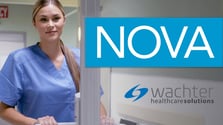Wachter Healthcare Solutions Discusses Patient Safety, Clinical Issues, & Staff Optimization at CMO Summit 2021
When it comes to the future of patient care in hospitals, remote patient monitoring serves as an important asset.
This year's virtual Chief Medical Officer (CMO) Summit covered topics of patient safety, staffing and retention, patient outcomes, and the future of patient care. Ashley Kuruvilla, MSN, APRN, FNP-C, NOVA Business Development Manager and Clinical Support Specialist, gave a keynote address to attendees on these topics.
Kuruvilla's presentation — "Virtual Patient Observation Solutions and Its Clinical Relevance and Impact on Healthcare" — detailed issues in clinical settings that impede patient safety efforts and introduced an innovative solution to address these challenges.
"My passion and driving force within my career has always been in helping others with a focus on preventative and proactive care," Kuruvilla said. "As healthcare professionals, we know the struggles we face with ensuring patient safety, addressing staffing issues, and increasing healthcare costs. Amid the current climate, these issues have only increased in prevalence."
Watch Ashley Kuruvilla's Full Keynote Address on Virtual Patient Observation Technology at CMO Summit 2021
Top Clinical Issues Facing Chief Medical Officers
CMOs across the nation experience similar problems when it comes to patient care — from preventing patient falls to staffing retention and optimization. Additionally, nursing shortages and high patient-to-nurse ratios lead to errors, nurse burnout, higher patient morbidity and mortality rates, and greater failure-to-rescue rates than facilities with lower patient-to-nurse ratios.
One of the common challenges facing healthcare facilities are patient falls. Falls can contribute to added morbidity issues leading to delayed patient recovery. The Agency for Healthcare Research and Quality (AHRQ) estimates that between 700,000 to 1 million patient falls occur in US hospitals each year. AHRQ also estimates that falls add an additional 6.3 days to the length of stay.
Until 2008, the Centers for Medicare and Medicaid Services reimbursed hospitals for in-patient fall costs. Now hospitals have to pay an average of more than $14,000 per fall.
"Because of this, the public is demanding more transparency from healthcare organizations than ever before and individuals are deciding where to seek care based on quality metrics including patient safety," Kuruvilla said.
Another issue facing hospital administrators is the cost of 1:1 hospital sitter programs. Estimates show that hospital sitter programs can cost hospitals anywhere from $500,000 to $2 million annually. Not only can these sitter programs increase budgetary expenses, but these programs do not always lead to better patient care outcomes.
Finding a solution that is cost-effective, relieves burdens on nurses, and focuses on patient safety is now a necessity for hospitals nationwide.
Remote Patient Monitoring Technology Shows Positive Impacts for Hospitals
Reducing falls, improving patient safety, and decreasing hospital sitter program costs is possible with innovative remote patient monitoring technology. A 2019 study published by the National Center for Biotechnology Information, found a 54% reduction in falls when video monitoring of patients was used.
One remote patient monitoring solution is NOVA (Nursing Observation and Virtual Assistant). This innovative technology has shown to reduce falls in hospitals. One 248-bed hospital in California reported a 38% decrease in both falls and sitter use within three months of using NOVA.
NOVA allows an observation technician to monitor up to 12 patients at once, alert nurses when immediate assistance is needed, and communicate with the patient via audio and/or visual prompts. NOVA is powered by reliable patient monitoring software to provide unified, real-time communication with patients and nursing staff. The NOVA solution improves staff workflow, freeing up nurses to perform essential duties during their shift, and prioritizing patients by patient care needs.
Another hospital in Connecticut used NOVA to safely monitor patients positive with COVID-19. This helped nurses monitor patients, provide care at crucial times, and reduce reliance on limited personal protective equipment (PPE).
"As healthcare professionals the responsibility falls on us to stay up to date with current research and innovative methods that aim to address relevant healthcare issues," Kuruvilla said. "The utilization of these solutions can aid in the administration of high-quality patient care that yields positive results for all."
- March 2nd, 2021
- Fall Prevention, Patient Safety, Patient Monitoring System




.png)
.png)
.png)